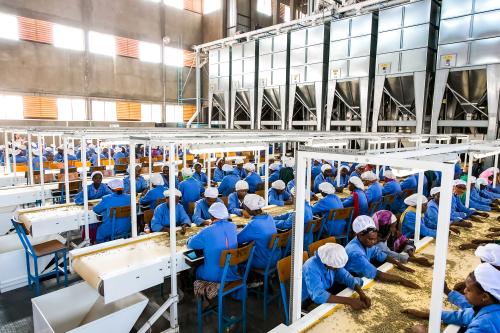Articles about employment issues in sub-Saharan Africa (SSA) often start by highlighting two widely accepted trends:
- Africa has a young labor force with high youth unemployment, and
- Despite high growth, Africa has not been creating jobs for these youth.
Often these trends are explained by a lack of structural transformation (a shift in the share of labor from low to high productivity sectors).
New research shows that these statements do not hold for much of the subcontinent. While there are exceptions—most notably South Africa and several resource-rich or fragile states—the economic growth registered since 2000 was accompanied by a steady growth in wage jobs, at a rate significantly faster than the growth of the labor force. Meanwhile, youth unemployment has been below world averages, controlling for income level. Unfortunately, this progress was interrupted by the COVID-19 health and economic crises, but it demonstrates the importance for job creation in African countries of getting back onto the path of economic stability and balanced economic growth as well as maintaining this trajectory through this decade.
Employment trends
Benchmarks are important for evaluating Africa employment outcomes. However, comparing levels and trends of employment outcomes in Africa with those of richer countries in other regions—such as China, Vietnam, or Mexico—sets an unreachable bar, and leads to disappointment. After all, these richer countries have much longer independent economic and political histories, and today have many more resources and much more wealth (human, financial, institutional) to work with. In our analysis, we compare African countries’ progress with that of other countries at their income level. In the paper, we use the income group definitions set by the World Bank and define countries as resource-rich (RR) if minerals accounted for at least 50 percent of exports during the 2006-2010. Here are our results.
- Wage employment, ideally with the security that a formal contract provides, is the job that most youth want, and the type of job that economic policy should aim to grow.
- Figure 1 (from the recently released paper) reveals that, in those sub-Saharan African low- and lower-middle-income countries not dependent on mineral exports to stimulate growth, wage jobs (formal and informal) as a share of total employment grew rapidly between 2000 and 2018. By 2018, in the non-RR lower-middle-income countries (LMICs), the share of wage employment was the same as in other countries in this income group in other regions, despite that fact that the average country in this group in other regions is richer. About half of this wage employment is informal, indicating that many workers remain in a vulnerable position, but this outcome also happens in other regions as well.
Figure 1. Wage employment in sub-Saharan Africa and the world, by income and resource dependence
Source: Fox, L. and Gandhi, D. Youth employment in sub-Saharan Africa: Progress and prospects. (Washington, DC: The Brookings Institution, 2021).
Data source: Employment distribution by status in employment—ILO Modelled estimates, ILOSTAT database.
- The share of wage employment in Africa’s low-income countries (LICs) is lower than in other regions, in part reflecting lower income levels in this group compared with other regions, and in part reflecting the poor growth performance of conflict-affected states such as Burundi, the Central African Republic, and Liberia.
- Africa’s RR LMICs did not grow their share of wage employment, nor did the countries in the upper-middle-income (UMIC) group. The latter group is dominated by the performance of South Africa (group averages are labor-force weighted), which was weak for most of this period. The group started the century with a higher share of wage employment than others at this income level, which may also explain that lack of growth in the share.
- Most of the growth of wage employment occurred in the private sector in non-RR countries. Less than 20 percent of wage employment in the non-RR LMICs countries is found in the public sector, compared with almost half in the RR LMICs
These employment trends are driven by structural transformation. Employment of all types—wage and self/family—in the agricultural sector declined in all groups, while employment in the services sector grew. Importantly, these trends show that Africa’s services sectors are creating wage employment and driving the structural transformation process. Manufacturing employment grew only at the pace of the labor force, and both manufacturing and construction shares in total employment remain below those found in other regions. Despite some increase in the share of output accounted for by manufacturing in Africa’s LICs and LMICs, many observers believe that Africa will not ever gain the manufacturing employment shares found in other regions. The data in Figure 2 likely understate the extent of structural transformation. If employment is measured by hours worked, total employment in agriculture is certainly overstated, as at least half of people working in agriculture have a second economic activity in nonfarm sectors, which aggregate data do not register.
Figure 2. Employment by sector and income group, sub-Saharan Africa and rest of world, 2018
Source: Fox, L. and Gandhi, D. Youth employment in sub-Saharan Africa: Progress and prospects. (Washington, DC: The Brookings Institution, 2021).
Note: Employment weighted average. Market services: trade, transportation, hospitality, ICT, and finance, real estate, and professional and administrative services. Nonmarket services: public administration, health, education and social work, arts, entertainment and recreation, and domestic services.
Data source: Employment distribution by economic activity—ILO modelled estimates, ILOSTAT database.
Youth unemployment
My research has previously noted that the youth (ages 15-24) share of the labor force in Africa is lower than most people think. In fact, youth are currently about one-quarter of the labor force in SSA. They are more likely to be unemployed than adults, but that fact is a worldwide phenomenon, accounted for by the issues young people face in making the school-to-work transition. Figure 3 shows the international trend in youth unemployment by income level.
Figure 3. GDP per capita and youth unemployment rate
Source: Fox, L. and Gandhi, D. Youth employment in sub-Saharan Africa: Progress and prospects. (Washington, DC: The Brookings Institution, 2021).
Data source: World Development Indicators (youth unemployment—ILO modeled estimate accessed via WDI).
Overall, youth unemployment in Africa is not higher than in comparator countries, except in the UMICs. In the LICs and LMICs, more than half of the African countries are under the trend line. In fact, youth unemployment in Africa follows the global trend in that unemployment is highest among the most educated youth in middle-income countries. As households and countries get richer, they have more resources to finance education and a job search. But job aspirations among the more educated youth rise as well, usually faster than the economy produces the jobs to which they aspire. In addition, technological changes mean that the demand for labor with mid-level skills (completed secondary education) is falling worldwide. Once countries reach high-income stage, their economies are better at producing jobs that use the skills of their highly educated youth, and job-matching improves as well.
These trends are surely worth celebrating, but early indicators suggest that, in Africa’s LICs and LMICs, the COVID-19 economic trauma knocked countries off this promising trend. While discouraging, we should not lose sight of Africa’s achievements in this century and the region’s potential. This is a lesson that all stakeholders should take to heart.
For more on AGI’s research into the potential for “industries without smokestacks” to create jobs for African youth and drive structural transformation, see Job creation for youth in Africa: Assessing the potential of industries without smokestacks or the results from the South Africa case study (summary here).









Commentary
Good news, Africa is creating jobs—but the narrative is complicated
April 6, 2021